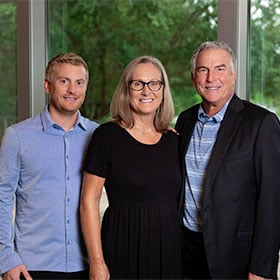Pentecost Family Myeloma Research Center
Moffitt Cancer Center has the largest multiple myeloma program in Florida and is world-renowned for its expertise in tackling this devastating form of cancer. Multiple myeloma is a hematologic malignancy of bone marrow resident plasma cells. Myeloma tumorigenesis is defined by both genetic transforming events, and the growth and survival factors provided by the bone marrow microenvironment. Multiple Myelomas remain incurable for roughly 85% of patients today. This makes finding new treatments and curative intent management strategies for patients all the more important — and Moffitt is poised to be at the forefront of these discoveries.
 The Pentecost Family Myeloma Research Center (PMRC) was created in 2021 with the Pentecost Family’s transformational gift and was built on the same core values as the institution itself — where multi-disciplinary teams use cutting-edge medicine to find the best treatments with rapid bench-to-bedside research. At Moffitt, we believe a cure for multiple myeloma is possible and within reach. To achieve this goal, a 10-year plan has been devised, featuring three main phases and four key areas of research and treatment.
The Pentecost Family Myeloma Research Center (PMRC) was created in 2021 with the Pentecost Family’s transformational gift and was built on the same core values as the institution itself — where multi-disciplinary teams use cutting-edge medicine to find the best treatments with rapid bench-to-bedside research. At Moffitt, we believe a cure for multiple myeloma is possible and within reach. To achieve this goal, a 10-year plan has been devised, featuring three main phases and four key areas of research and treatment.
Personalizing Medicine With EMMA
Over the past three years, Moffitt Cancer Center has focused on developing EMMA (Ex Vivo Mathematical Myeloma Advisor) from a research tool into a clinical assay that provides oncologists with critical information regarding application of the right therapy, at the right time, for the right patient. This work has led to over 40 manuscripts, three extramural grants and integration of the EMMA platform into two Phase II Moffitt investigator-initiated clinical trials.
Each multiple myeloma patient has a bone marrow biopsy before starting treatment. If they would like to participate in EMMA, they can choose to have a portion of their biopsy sent for analysis. In the lab, multiple myeloma cells are isolated from each biopsy and cultured overnight. The next day, the cells are dosed with 31 different multiple myeloma drugs. For the next five days, powerful digital microscopes snap live images of how the cells react to each drug every 30 minutes. The digital imagery is then used in combination with patient- and drug-specific mathematical models to predict how the individual will respond to the different therapies. The results are reviewed during the clinic’s weekly tumor board meetings and assist the medical team in making real-time decisions on therapeutic management for those patients.
Key Areas of Research and Treatment
PRECURSOR STATES
Understanding precursor conditions is a fundamental part of developing new strategies to determine when, and in which patients, therapeutic intervention is appropriate. We believe that Moffitt’s personalized approach — to an individual’s myeloma genetic makeup and biology — holds the key(s) to preventing and curing multiple myeloma.
RESPONSE ADAPTED THERAPY
Myeloma is a heterogenous disease, meaning that it can behave very differently from patient to patient. With a better understanding of the biology of the disease, and the many treatment options available, we should be able to tailor each patient’s treatment according to response. Response adapted therapy will allow us to intensify therapy on those patients who need it or ease therapy in those patients who have already achieved an optimal response. We continue clinical trials incorporating this treatment approach both in the newly diagnosed and maintenance settings- striving for personalized management strategies for our multiple myeloma patients.
CELLULAR IMMUNOTHERAPIES
Chimeric antigen receptor (CAR) T therapy is changing the way the world approaches cancer treatment — and with an 85% response rate that often results in a complete response in patients with advanced multiple myeloma, its popularity and reputation are well earned. At Moffitt, one of the nation's leading CAR T centers, we see more potential for these and other powerful T cell engaging therapies, especially when they are administered to patients earlier in their treatment plan, when they are healthier and have less burden of disease.
NOVEL DRUG DEVELOPMENT FOR RECURRENCE
Patients with relapsed multiple myeloma have limited therapeutic options. Simply put, there is an urgent need for more tools to fight this disease for patients who have failed multiple lines of therapy. New agent development has altered the treatment landscape and improved outcomes for patients around the world. Most of these therapeutics were developed from a better understanding of the biology of multiple myeloma and the immune system. A major goal of the Pentecost Family Research Center is to develop new and effective multiple myeloma therapies.
This center, led by Dr. Rachid Baz, Dr. Ken Shain and Dr. Melissa Alsina, currently involves more than 20 faculty members from different departments at Moffitt, including: Malignant Hematology, BMT-CI, Tumor Biology, Integrated Mathematical Oncology, Cancer Physiology, Hematopathology, Biostatistics & Bioinformatics, and Immunology. The group has an overall focus on translating discoveries made at Moffitt to transform care for myeloma patients, to develop new therapies and strategies for improving quality of life and, where feasible, to eradicate multiple myeloma. Investigators work towards these goals as integrated research teams, developing innovative ideas from the bench to the bedside.
Members:
Daniel Abate Daga, PhD
Melissa Alsina, MD
Rachid Baz, MD
Brandon Blue, MD
Jason Brayer, MD, PhD
Omar Castaneda-Puglianini, MD
Dung-Tsa Chen, PhD
John Cleveland, PhD
Chris Cubitt, PhD
William S. Dalton, PhD, MD
Ariel Grajales-Cruz MD
Ciara Freemen, MD
Doris Hansen, MD
John Koomen, PhD
Nicholas James Lawrence, PhD
Hien Liu, MD
Fred Locke, MD
Conor Lynch, PhD
Taiga Nishihori, MD
José L. Ochoa-Bayona, MD
Kenneth Shain, PhD, MD
Ariosto Silva, PhD
